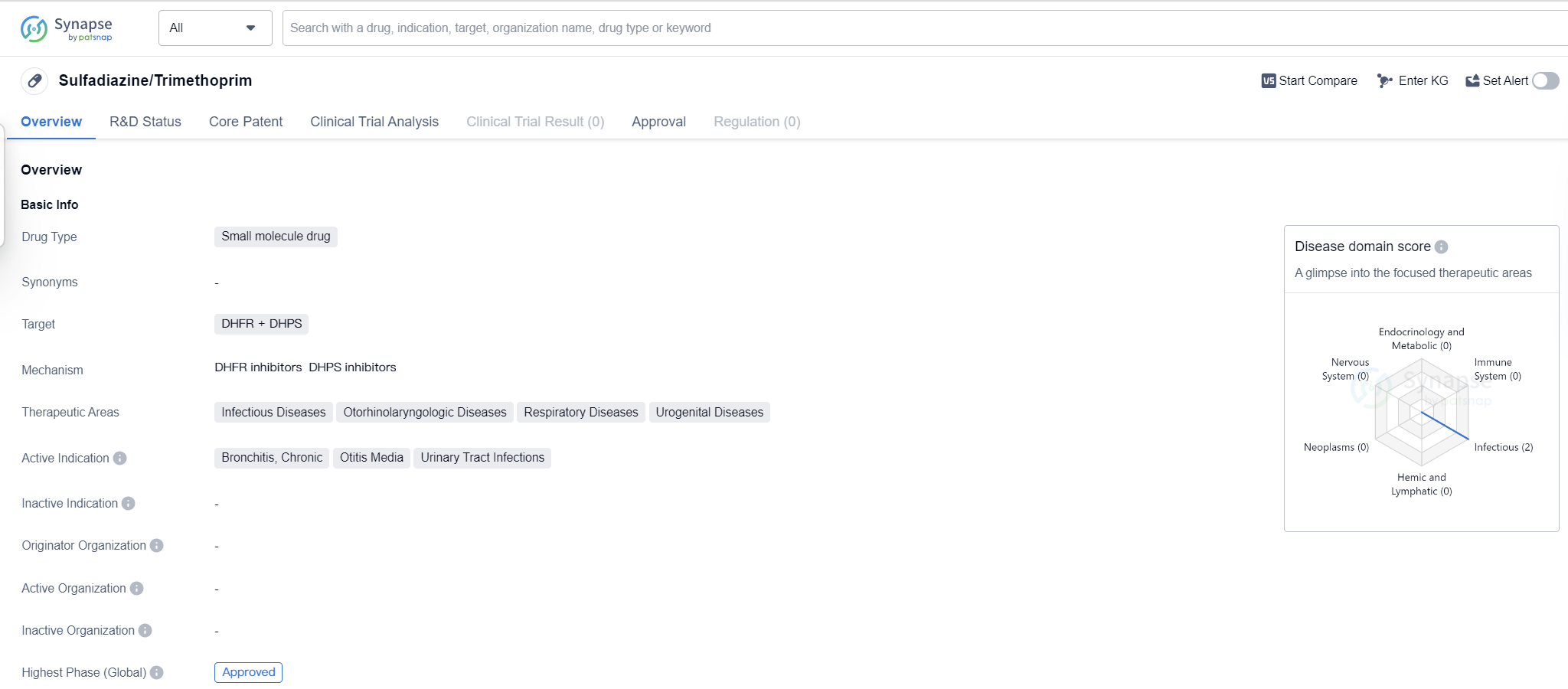Pharmaceutical Insights: sulfadiazine/trimethoprim's R&D Progress
Sulfadiazine/trimethoprim's R&D Progress
The drug Sulfadiazine/Trimethoprim is a small molecule drug that targets DHFR (dihydrofolate reductase) and DHPS (dihydropteroate synthase). It is primarily used in the treatment of infectious diseases, otorhinolaryngologic diseases, respiratory diseases, and urogenital diseases. The active indications for this drug include bronchitis, chronic otitis media, and urinary tract infections.
In terms of its development, Sulfadiazine/Trimethoprim has reached the highest phase of development which is approved globally. This indicates that it has successfully undergone rigorous testing and evaluation to demonstrate its safety and efficacy in treating the specified conditions.
As a small molecule drug, Sulfadiazine/Trimethoprim is likely to have a well-defined chemical structure and relatively small molecular weight. This characteristic allows it to be easily absorbed and distributed within the body, potentially leading to efficient therapeutic effects.
The drug's specific targets, DHFR and DHPS, are enzymes involved in the synthesis of essential components for bacterial growth. By inhibiting these enzymes, Sulfadiazine/Trimethoprim disrupts the metabolic pathways necessary for bacterial survival, ultimately leading to their death or inhibition of growth. This mechanism of action makes it an effective treatment option for various infectious diseases caused by susceptible bacteria.
The therapeutic areas associated with Sulfadiazine/Trimethoprim highlight its broad spectrum of activity against different types of infections. Infectious diseases encompass a wide range of conditions caused by bacteria, viruses, fungi, or parasites. Otorhinolaryngologic diseases refer to infections affecting the ears, nose, and throat, while respiratory diseases involve the lungs and airways. Urogenital diseases involve infections of the urinary tract and reproductive organs.
The active indications for Sulfadiazine/Trimethoprim include bronchitis, chronic otitis media, and urinary tract infections. Bronchitis is characterized by inflammation of the bronchial tubes, often resulting from a respiratory infection.
👇Please click on the image below to directly access the latest data (R&D Status | Core Patent | Clinical Trial | Approval status in Global countries) of this drug.
Mechanism of Action for sulfadiazine/trimethoprim: DHFR inhibitors DHPS inhibitors
DHFR inhibitors and DHPS inhibitors are two types of drugs that target specific enzymes involved in the synthesis of folate, an essential vitamin for cell growth and division.
DHFR (Dihydrofolate reductase) inhibitors are a class of drugs that inhibit the activity of the enzyme dihydrofolate reductase. This enzyme plays a crucial role in the synthesis of tetrahydrofolate, which is required for the production of DNA, RNA, and certain amino acids. By inhibiting DHFR, these drugs disrupt the folate cycle in cells, leading to a deficiency in folate-dependent processes and ultimately inhibiting cell growth and division. DHFR inhibitors are commonly used in the treatment of various diseases, including cancer, bacterial infections, and autoimmune disorders.
DHPS (Dihydropteroate synthase) inhibitors are drugs that target the enzyme dihydropteroate synthase. This enzyme is involved in the synthesis of dihydropteroic acid, a precursor molecule in the folate synthesis pathway. By inhibiting DHPS, these drugs interfere with the production of folate, which is necessary for the synthesis of DNA and RNA. DHPS inhibitors are primarily used as antibiotics to treat bacterial infections, particularly those caused by the bacteria of the genus Streptococcus and Staphylococcus.
Both DHFR inhibitors and DHPS inhibitors are important therapeutic agents that selectively target enzymes involved in folate metabolism. By disrupting folate synthesis, these drugs can effectively inhibit the growth and proliferation of cells, making them valuable in the treatment of various diseases.
Drug Target R&D Trends for sulfadiazine/trimethoprim
DHFR (dihydrofolate reductase) and DHPS (dihydropteroate synthase) are enzymes that play crucial roles in the human body. DHFR is responsible for converting dihydrofolate into tetrahydrofolate, a vital coenzyme involved in DNA synthesis, amino acid metabolism, and cell division. It is also a target for certain antibiotics and anticancer drugs. On the other hand, DHPS is involved in the synthesis of dihydropteroate, a precursor for the production of folate. Folate is essential for the synthesis of DNA, RNA, and proteins. Inhibition of DHPS is a mechanism employed by some antibiotics to treat bacterial infections. Understanding the functions of DHFR and DHPS is crucial for developing drugs that target these enzymes to treat various diseases.
According to Patsnap Synapse, as of 16 Sep 2023, there are a total of 9 DHFR + DHPS drugs worldwide, from 3 organizations, covering 15 indications, and conducting 31 clinical trials.
The analysis of the current competitive landscape and future development of target DHFR + DHPS reveals several key findings. Heilongjiang Linbao Pharmaceutical Co., Ltd, Dafra Pharma International NV, and Sun Pharmaceutical Industries Ltd are the companies growing the fastest under this target, with drugs approved or in development. The indications for drugs targeting DHFR + DHPS cover a wide range of infectious diseases, indicating their potential in treating various conditions. Small molecule drugs are progressing rapidly, with several approved drugs. China is leading in terms of development, with the highest number of approved drugs. Overall, the target DHFR + DHPS shows promise in the pharmaceutical industry, with ongoing research and development efforts focused on its potential therapeutic applications.
👇Please click on the picture link below for free registration or log in directly if you have a freemium account, you can browse the latest research progress on drugs, indications, organizations, clinical trials, clinical results, and drug patents related to this target
Conclusion
Overall, Sulfadiazine/Trimethoprim is an approved small molecule drug that targets DHFR and DHPS. It is used in the treatment of various infectious diseases, otorhinolaryngologic diseases, respiratory diseases, and urogenital diseases. With active indications for bronchitis, chronic otitis media, and urinary tract infections, this drug offers a valuable therapeutic option for patients suffering from these conditions.






